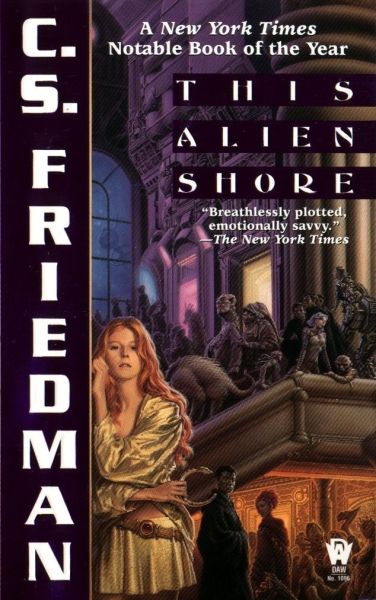All Kinds of Kinds
This Alien Shore
By C. S. Friedman

2 Mar, 2019
C. S. Friedman’s This Alien Shore is a standalone space-opera/cyberpunk novel.
The Hausman drive gave humanity the stars. It also induced mutations in crew, passengers, and colonists. The mutations thrived in the new colonies, which became known as Variants. A bigoted, xenophobic Earth abandoned its colonies. Two centuries later, the Guerans developed an entirely new method of faster-than-light travel, via ainniq, points that give access to an alien realm governed by unfamiliar laws. The Gueran Guild reached out to all of humanity’s worlds, including standoffish Earth, and rebuilt the interstellar community Earth had cast aside.
Now someone is trying to destroy that community.
When her Earth-orbiting home habitat is targeted by raiders, Jamisia’s guardian manages to hustle her onto an escape pod and send the young teen to the ainniq nearest Earth1. The habitat is destroyed, but not before Jamisia receives a last message: she was the treasure the raiders had hoped to steal.
Hoping to evade further pursuit, Jamisia adopts a new identity. Wise move: not only are the raiders still looking for her, but they’ve framed her for the destruction of her home. Jamisia has a few advantages in this chase: she has exceptionally powerful brainware and she’s not neurotypical. She holds multiple minds, each of which has powers that can help her escape.
This is a bad time for flight across the star lanes. Someone, somewhere is spreading a computer virus dubbed Lucifer that attacks starship pilots. It moves from brainware to brainware; first it spies, then it destroys. Pilots go insane. Some kill themselves, taking their ships and passengers with them. Doctor Kio Masada is charged with finding the culprits and stopping Lucifer. He suspects that the virus is being spread by Terrans who still hate the Variants and the Guerans. If that’s true, the consequences (for the Earth and the interstellar community) could be dire.
~oOo~
It might seem from the synopsis above that the Jamisia and the Lucifer plots might not have much to do with each other. That’s because they don’t. They happen in the same setting and the two plot threads get close enough to wave at each other. You might expect the plucky teen to solve the problem the established genius could not solve. That is not the direction the author took. With a bit of editing this book could have been turned into two standalone novels. It’s an interesting plotting choice.
I was bemused by the author’s insistence that each Variant world has its own variety of human Variation. Planet X has X Variants, Planet Y is inhabited by Y Variants. This seems odd. One would expect a mutagenic drive to produce a random array of mutations, not one variation per trip. Perhaps the homogenous populations are due to two centuries of isolation (thanks to Earth abandoning starflight), plus variation plus natural selection by each world’s peculiar conditions. That’s a big perhaps.
I was reminded of another Friedman novel, In Conquest Born, recently reviewed here. In both the Azean Empire and Earth, hi-tech is used to homogenize the population. The non-phenotypical and non-neurotypical are feared and hated. The author doesn’t approve, as she makes clear again and again2.
It’s odd to see a book that could be classified as cyberpunk published as late as 1999, although I note that Kingsbury’s Psychohistorical Crisis, which shares similar worldbuilding elements, was published even more recently (2001).
There are some elements in this book that are prescient rather than nostalgic: malefactors spreading malware and fake news to foment discord and undermine faith in government seems pretty darn timely, even though this novel is a generation old now.
Readers of a certain vintage may be reminded of Cordwainer Smith (if not, then perhaps it is time for me to review Smith Best Of, at least, or for readers to consider this anthology and this novel). Like Smith, Friedman depicts a vast galaxy filled with diverse human kinds3. Like Smith. Friedman is more stylistically ambitious than most space opera authors. As well, her characters are more vividly portrayed than is the custom in a genre that places more emphasis on thrilling action and explosions than on nuances of character.
This Alien Shore is an intriguing introduction to a universe with potential. Shame it seems to be a standalone.
This Alien Shore is available here (Amazon), here (Amazon.ca), and here (Chapters-Indigo).
1: Three years travel from Earth. Ainniq to ainniq travel is extremely fast but ainniqs appear to follow their own paths through the Milky Way. There is no guarantee that any given ainniq will be close to a star. At least one guild member is baffled why anyone bothers to live on planets, given that habitats are proven technology and can be built conveniently close to ainniqs, whereas planets are probably going to be months or years from the nearest contact point.
2: But the author doesn’t seem to care about those who challenge gender conventions, despite one of Jamisia’s personalities being male.
3: That said, Smith had far more conservative views.
